Reduce Lawns
Turf grasses are typically exotic monocultures, in other words, they consist of a single species, a species often not native to the area where they are planted. The widespread use of these turf grasses has lead to a number of environmental concerns.
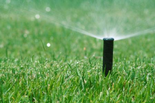
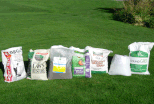
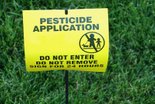

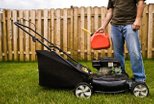
Water Usage
In peak summer months, as much as 50% of the water provided by utilities may be used to maintain turf grass lawn. With growing droughts in our country it is fair to question this type of water usage.
Fertilizer
Turf grasses, particularly cool season turf grasses, require the use of fertilizers to maintain their vigor. Regretfully, fertilizers often run off and contaminate nearby lakes, streams, ponds, and even drinking water supplies. Run off from fertilizers has been blamed for excess growth of algae and aquatic plants in lakes and coastal regions, and has far reaching consequences.
Pesticides
Monocultures, like turfgrass lawns, are more likely to succumb to disease and infestations of particular organisms. Pesticides never target only one type of organism. Application of pesticides has the effect of killing a pest, but other organisms will die as well, which creates a situation in where the grass will be even more prone to future infestations, since the natural protection against pests is lost.
Herbicides
Roundup (glyphosate) is officially classified by International Agency for Research on Cancer as probably carcinogenic to humans, but the precise effects of this popular weedkiller remain usure. The bottom line is, although we use enormous amount of herbicides (1.6 billion kilograms of Glyphosate in the USA alone), we still don't know the exact effect of herbicides on us and our environment. What we do know is that pollinators feed on dandelions, violets, clover and other flowers in our yard, and that without those flowers we damage our environment
Pollution
One of the desirable effects of a monoculture is its uniformity, which, with turf grass, is maintained by gasoline driven lawnmowers. Unlike passenger cars, landcaping engines are not regulated and are highly polluting. It is estimated that landscaping equipment contributes around 10% of our country's pollution.
With the growing number of evironmental concerns related to our lawns, it makes sense to reconsider our lawns.. The question is, how can we change our habits, create healthier yards, while garanteeing the livelihood of the landscaping business? The answer is a number of alternative, more sustainable practices that can be offered as regularly, and with the same pay check, as the older practices.
How to Remove Turf
Hebicides
There are a number of herbicides that will kill turf grass, but most are substances that are highly toxic to more than just turf grass. Many of these herbicides are residual and carry a serious risk of ending up in the water supply. Some choices, such as glyphosate (the active ingredient in Roundup™), are less residual, but this would be a very expensive way to remove your lawn.
In short, we would not suggest using an herbicide for turf removal unless your lawn area was very small.
Mechanically Removing
The fastest way to remove a lawn is to physically remove the sod by cutting it into strips with a sod cutter, rolling the strips up, and either taking them away or turning them over and letting them compost in place. The cut sod can be laid upside down in the middle of the area being removed, to create a mound, as fill in a low spot or to create a berm if needed elsewhere in the garden. Whether moving to a new spot, or composting in place, cover with a layer of newspaper (6-10 sheets thick, and overlapping) and 4-6 inches of compost, and lastly with 3-4 inches of mulch to decompose, create good soil, and prevent grass re-growing. (Note that if you leave the sod in place, or mound it, you're turning a quick method into a slower one.)
You can do the same thing in a small area with a flat shovel, but it is labor intensive.
Removing sod doesn't work if you have a persistent perennial lawn grass like Bermuda grass. Simply removing the sod on Bermuda guarantees that it will be back, since the roots go down for several feet, and it only takes an inch of root to grow it all back. In this case, the only way to get rid of the lawn is through solarization (or herbicides)—plus several months of waiting to be sure it's really gone.
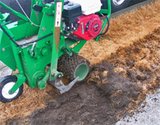
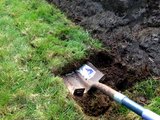
Solarizing
Technically, solarization is a method of soil sterilization using clear plastic, but a version, which might be called 'light exclusion' using black plastic, works for lawn removal. This method works best in areas with high summer temperatures, and should be done as spring is turning to summer. Cut the grass as short as possible and water well. Cover with large rolls of sturdy black polyethylene held in place by rocks or metal stakes. Cover the area, making sure it is airtight with no holes. The plastic sheets allow the sun's radiant energy to be trapped in the soil, heating the top 12 to 18 inches. When properly done, the top 6 inches of the soil will heat up to as high as 140°F, depending on the location. Leave in place for about 4--8 weeks—depending on how hot the weather is--until grass is dead. The high temperature may also kill some insects, plant diseases, nematodes and soil pathogens in the top layer of soil. Remove the plastic, and leave the dead grass to compost in place. This method also requires minimal labor and has minimal environmental impact. However, it takes a fair amount of time, must be done in hot weather and is unsightly.
Sheet Composting
Cut the grass as short as possible. Cover the entire area with cardboard (either used boxes or purchased rolls) or newspaper (10-12 layers). Make sure that the edges overlap a goodly amount and no sunlight gets through the paper. Water paper, cover with a layer of compost, then mulch at least 4 inches thick. You can scatter grass and/or wildflower seeds in the compost if you're looking for a 'meadow' (before you apply the mulch). You can also cut holes in the paper to plant individual plants, or wait until the paper has decomposed and dig planting holes for your new plants. This method adds organic matter to soil, requires minimal labor, and does not require removal and disposal of turf. It also takes a fairly long time, and is not practical on steep slopes.
